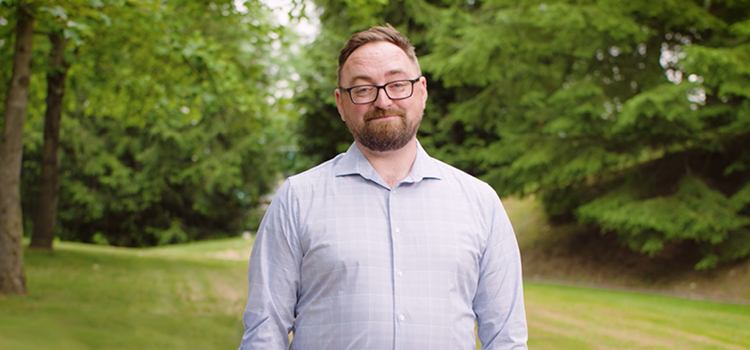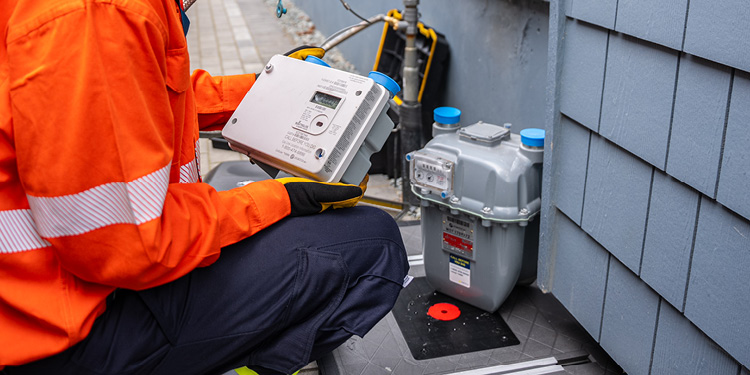Ready for wildfire season: the steps we take and how you can prepare
July 1, 2025
Wildfires are an unfortunate reality in B.C. They can cause considerable impact to communities. We talked to members of our team about how FortisBC prepares for wildfire season to help keep our communities and infrastructure safe. They shed some light on our proactive wildfire safety practices, and what you can do to prepare.
7 steps we take to protect against wildfires
The 2023 wildfire season was the most destructive in British Columbia's recorded history. When Taras (T.M.) Sandulak, FortisBC’s manager of emergency management, recalls that wildfire season, he remembers how his team came together to respond to wildfire incidents.
“Our team came together quickly and started communicating, collaborating and working with external agencies,” says T.M. “We train for these kinds of scenarios all the time—we were ready.”
Emergency response exercises
We’re one of many organizations that respond to emergencies in your community. We hold 30 to 35 emergency response training exercises, on average, at our facilities every year, to prepare for wildfires and other emergencies such as earthquakes, floods, line hits or storm damage. The majority of these trainings are held in collaboration with our public safety partners and emergency responders.
We also meet with our operations teams to talk through different scenarios that are likely to occur during an emergency. “We talk about what policies and practices operationally need to happen, and test them through simulated exercises, to identify any gaps in our processes,” says T.M. “If there’s anything that doesn’t work, we go back to the table with everyone involved to enhance our emergency response.”
In addition to the emergency response and field operations teams, other departments from across the company may be included in the exercises—depending on the type of emergency exercise—to practice their plans and keep their response skills sharp. For example, team members from public affairs, employee and external communications, customer service, community relations, Indigenous relations—and other departments—may all be invited to participate as needed.
“The importance of being prepared to respond to an emergency can’t be overstated,” says T.M. “Where wildfire preparedness is concerned, our proactive wildfire safety practices help reduce the risk of wildfires.”
Vegetation management and power line inspections
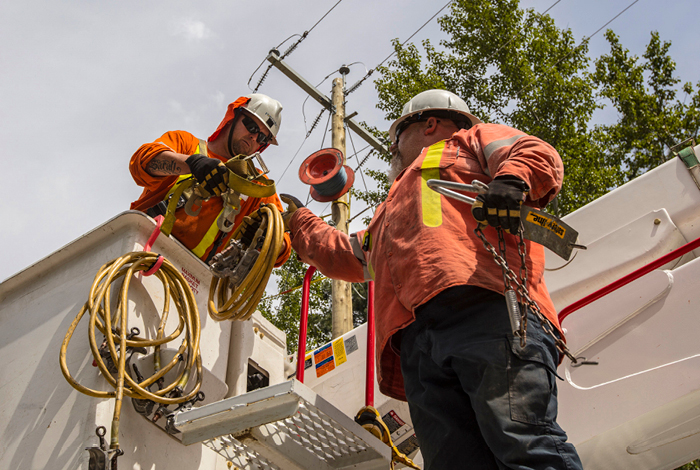
We conduct vegetation management year-round to help keep trees and other vegetation from falling on, or touching, our power lines. We remove dead trees that could fall over onto a line during a windstorm, trim tree branches and bushes that are growing too close to our lines and remove debris near our infrastructure—all of which could become fuel for a wildfire.
Fire blankets and fire suppression material
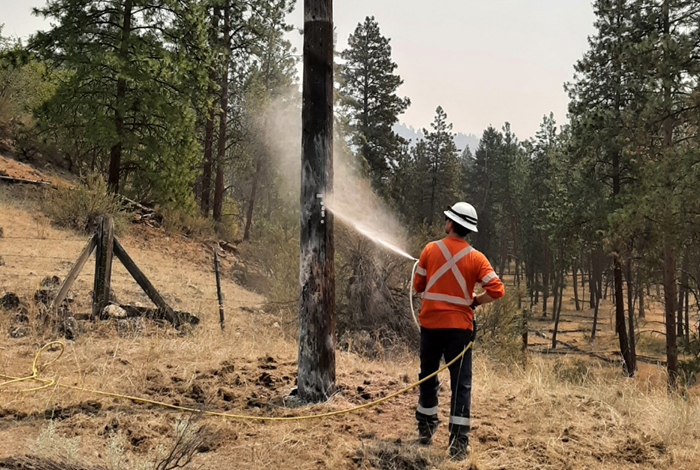
We may apply fire blankets and fire suppressant material to equipment as a preventative measure. “We assess what areas might be under threat, or risk of wildfire and we may deploy those measures ahead of time,” notes T.M. “We can also do it in fairly short order. We work closely with the B.C. Wildfire Service. If they’re on high alert, or busy fighting an active wildfire, we’ll work with them to gain safe access to get the suppressant and fire blankets down around our stations and equipment.”
Power line safety settings
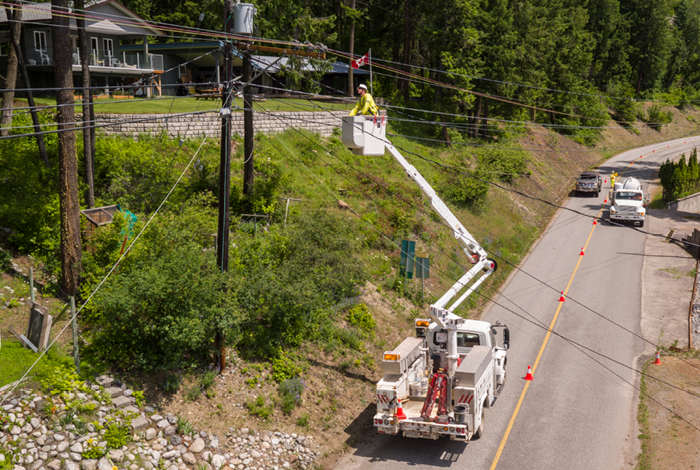
When wildfire risk is high, for example when campfire bans come into effect, we turn on our enhanced safety settings on our power lines to make them more sensitive. “With enhanced safety settings, when a problem is detected on a power line, the system will turn off power faster than our standard setting,” says T.M. “Rather than our system trying to restart the power line automatically, the power stays off until the entire line is patrolled by a technician to make sure it’s safe to restore power.”
Supporting firefighters during active wildfires
This is an ongoing measure where we closely monitor wildfires near our equipment and determine when to turn the power off to support firefighting efforts and the safety of firefighters. “During active wildfires we work very closely with firefighting authorities to determine the most appropriate time and place to shut the power off if there is a risk of electricity interfering with firefighting operations—whether that’s during aerial firefighting or on the ground,” says T.M. “For example, during the 2023 Kelowna wildfires, we were asked to keep power on at one point, because it was required to serve water pumps that were essential for firefighting operations. That’s why we work very closely with fire officials to understand what infrastructure and systems are most critical to the community.”
Public Safety Power Shutoff
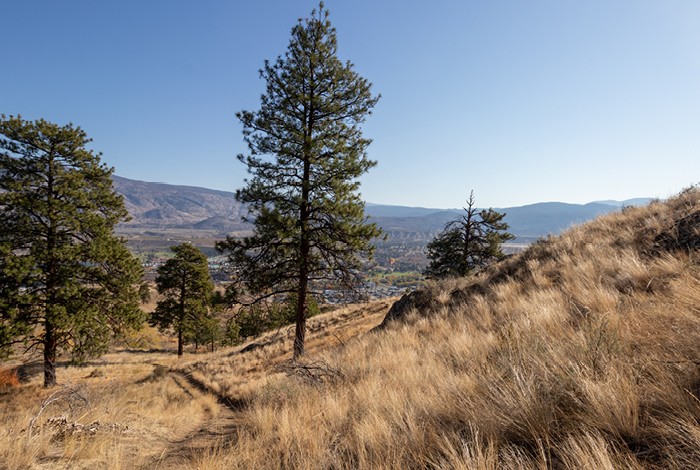
Our goal is always to keep your power on, but should wildfire conditions become extreme, we need to be prepared ahead of time. That’s why we developed a Public Safety Power Shutoff (PSPS) policy as part of our wildfire safety practices.
A PSPS event involves careful monitoring of wildfire-risk weather conditions and temporarily shutting off specific power lines to reduce potential ignition sources should weather conditions become extreme.
The extreme weather conditions that would prompt us to consider initiating a PSPS event includes both of the following:
- Fire Weather Index (FWI) of 47 or more (a rating of 30 is considered extreme1)
- sustained wind speeds over 75 kilometres per hour
“PSPS is another important tool in our box to help us affect a good wildfire incident response—but it’s a tool of last resort that we anticipate will be rarely used,” says T.M. “The weather conditions that would meet the criteria for a PSPS event are much more extreme than an average hot, sunny day.”
 | T.M. emphasizes how committed the FortisBC team is to safety and keeping the power on for our customers, “We want to give people some comfort in knowing there is a dedicated team of people at FortisBC who are actively planning for, preparing for and monitoring emergencies. We’ve devoted a lot of time to developing our capabilities and expertise in mobilizing a quick response to emergencies.” |
Industry experts reviewed 10 years of historical weather data within the areas in our service territory at greatest risk of wildfire. Within that data, we found only one occurrence of weather conditions that would have met the criteria for a PSPS event.
Taras (T.M.) Sandulak, FortisBC’s manager of emergency management
How to prepare for wildfire season and possible power outages
As FortisBC’s public safety program manager, Ada Nadison wants to ensure customers have the information they need to keep their families and homes safe during wildfire season.
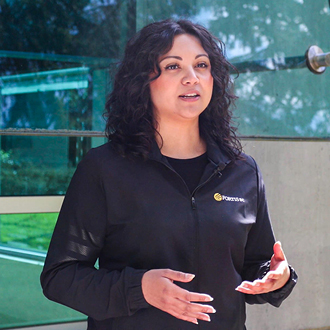 | “Public safety is a top priority for FortisBC. We have wildfire safety practices in place to make sure that we do what we can to protect our customers,” states Ada. “But everyone has a role to play in emergency planning and response. In most emergencies, the first people to respond are neighbours, family members or local community members—not emergency personnel. Having a plan, supplies and knowledge empowers individuals to act quickly and effectively before outside help arrives.” |
You just never know what can unfold during or after a wildfire incident. Once you’re in the midst of a wildfire, you’re at the beck and call of mother nature. We should all be prepared for emergencies of any kind, including a power outage.
Ada Nadison, FortisBC’s public safety program manager
During an active wildfire, FortisBC works closely with local communities, regional districts and other governments and agencies to coordinate emergency response activities. Ada notes, “Every agency will be doing the best they can, but they’re going to be so busy with the response that they won’t have time to support every individual fully. There will be some supports in place, but they’ll only be temporary. Personal preparedness builds community resilience. When individuals are prepared, they’re better positioned to help others—especially vulnerable neighbours.”

Here are Ada’s top tips for getting ready for wildfire season to keep your home and family safe:
1. Subscribe to emergency information in advance
Before an emergency hits, find out how you can obtain real-time information about what’s going on in your community. Doing your research about what information is available and subscribing to email or text distribution lists or downloading apps on your phone in advance, will help give you peace of mind knowing you’ll have the information you need when you need it. For example, you can sign up for FortisBC’s PSPS notifications, or download the Alertable app. We use Alertable as part of our emergency alerts. You can also select the specific communities or municipalities across the province that you’d like to receive alerts for.
2. Do a FireSmart™ audit of your home
Look up FireSmart safety tips and put those practices into place in your home to make it more resilient. Some simple FireSmart tips include:
- Prune trees to create a two-metre clearance from the ground to the lowest branches.
- Keep grass and weeds cut below 10 centimetres.
- Reduce the flammability of your landscaping and plant wildfire-resistant vegetation.
- Clean and maintain the exterior of your home, including gutters, roofs, decks (above and below) and balconies to keep them free of combustible materials, such as leaves, branches and other debris.
- Establish a 1.5 metre non-combustible zone around the perimeter of your house and deck.
3. Make a family plan
Have a conversation with your family about how wildfire risk has been increasing over the last number of years and how important it is to be ready for an emergency. For example, what happens if Mom is at work, the kids are at school and Dad is somewhere else when you get a notification for a potential evacuation?
The worst thing during an emergency is that sense of panic. Most people panic because they don’t have a plan.
Ada Nadison, FortisBC’s public safety program manager
What’s the plan? Where do you meet? Who do you call and how do you get from point A to point B? The emergency plan is going to be different for every family. Write your plan down and post it in a prominent place in your home.
4. Assemble an emergency preparedness kit
Your kit should contain enough supplies to last your family for two to three days. A basic kit should include items such as food, water, first aid kit, flashlight and a battery powered radio. Be sure to include important family documents and medications for you and your pets. Visit getprepared.gc.ca for more information.
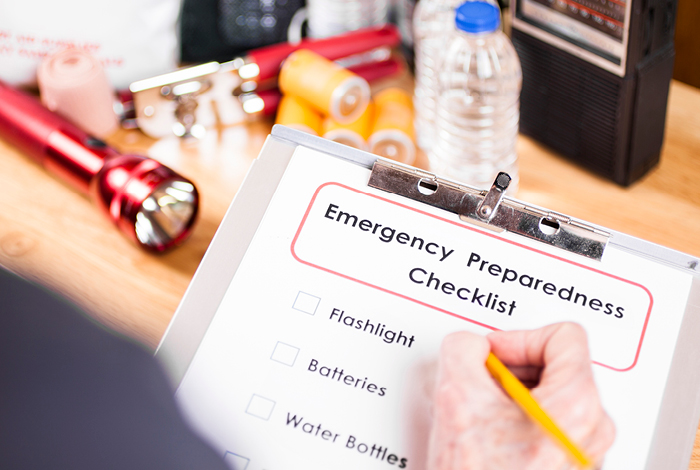
“Wildfire preparedness and outage preparedness go hand in hand,” says Ada. “Everything can become disconnected during a wildfire incident. When you’re thinking about your preparedness, you need to think much broader than an outage. You may be able to hunker down in your home during an outage, but that’s the best scenario—you might also be forced to evacuate during wildfire season. It’s important to be prepared for all possible scenarios.”
Find out more information about outage preparedness and our wildfire safety practices.
1Natural Resources Canada, Fire Weather Index, Interactive Map.

